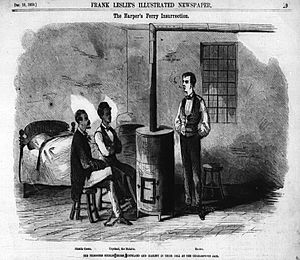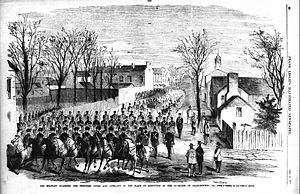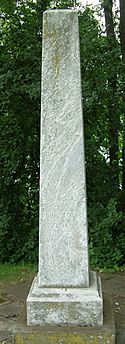John Anthony Copeland Jr. facts for kids
Quick facts for kids
John Anthony Copeland Jr.
|
|
|---|---|

John Copeland in 1859, drawing from a newspaper, likely made during his trial
|
|
| Born | 1834 Raleigh, North Carolina, United States
|
| Died | December 16, 1859 (aged 24–25) |
| Cause of death | Hanging |
| Education | Oberlin Collegiate Institute |
| Known for | Oberlin-Wellington Rescue Raid on Harpers Ferry |
John Anthony Copeland Jr. (August 15, 1834 – December 16, 1859) was a free African American who played a brave role in the fight against slavery in the United States. He was born in Raleigh, North Carolina, one of eight children. His parents, John Copeland Sr. and Delilah Evans, were both free. His father had been freed from slavery by his owner's will.
In 1843, his family moved north to Oberlin, Ohio. This town was a major center for people who wanted to end slavery, known as abolitionists. John Copeland Jr. later attended Oberlin College's high school program. He became a well-known leader in the Oberlin–Wellington Rescue in 1858. This event helped a runaway enslaved person gain freedom.
Copeland later joined John Brown's famous raid on Harpers Ferry. He was one of the few raiders who was already well-known before the raid. He was captured and later found guilty of serious charges related to his actions. He was executed on December 16, 1859. His family tried to get his body back, but they were not successful.
Early Life and Family
John Copeland Jr.'s father, John Anthony Copeland, was born into slavery in 1808 near Raleigh, North Carolina. His mother, Delilah Evans, was born free in 1809. John Sr. was freed from slavery around 1815 by his owner's will, who was also his father.
As a young man, John Sr. married Delilah Evans. They lived near Hillsborough, North Carolina, until 1843. The family then moved to escape unfair treatment because of their race. They first went to Cincinnati, Ohio, and then settled in Oberlin. Some of Delilah's brothers and their families also moved there. John Sr. worked as a carpenter and also as a Methodist preacher.
John Jr. also became a carpenter. He briefly studied at Oberlin College's high school division. His letters show that he was very good at reading and writing. People described him as well-educated and friendly.
Fighting Against Slavery
John Copeland Jr. became very involved in the anti-slavery movement. He joined the Oberlin Anti-Slavery Society as a young man.
In September 1858, Copeland, along with his uncles Henry and Wilson Bruce Evans, led a group of 37 men. They were part of an event called the Oberlin–Wellington Rescue. In this rescue, they freed John Price, a runaway enslaved person. Price had been captured by authorities under the 1850 Fugitive Slave Act. The group helped Price escape to Canada. Copeland was charged for his part in this rescue, but he was not arrested. He was actually a fugitive himself when he joined John Brown.
In September 1859, Copeland was asked to join John Brown's plan to raid Harpers Ferry. His uncle, Lewis Sheridan Leary, who was also a raider, asked him to join. Copeland's job in the Harpers Ferry attack was to take control of Hall's Rifle Works, along with another raider named John Henry Kagi. Kagi and others were killed trying to escape by swimming across the Shenandoah River. Copeland was captured alive in the middle of the river.
Copeland, Brown, and five others were held for trial by the state of Virginia. Copeland was also visited by marshals who wanted him for the Wellington rescue charges. He told the marshals everything that happened.
At his trial, Copeland was found guilty of serious charges related to his actions. He was sentenced to death by hanging. A charge of treason was dropped. His lawyer argued that Copeland could not commit treason because, according to the Dred Scott decision by the Supreme Court, African Americans were not considered citizens.
Six days before he was executed, Copeland wrote a letter to his brother. He compared his actions to the American Revolution:
And now, brother, for having lent my aid to a general no less brave, and engaged in a cause no less honorable and glorious, I am to suffer death. Washington entered the field to fight for the freedom of the American people—not for the white man alone, but for both black and white. Nor were they white men alone who fought for the freedom of this country. The blood of black men flowed as freely as the blood of white men. Yes, the very first blood that was spilt was that of a negro... But this you know as well as I do, ...the claims which we, as colored men, have on the American people.
Another letter showed his strong religious beliefs from his time in Oberlin. In a letter on December 16, Copeland wrote to comfort his family:
Why should you sorrow? Why should your hearts be racked with grief? Have I not everything to gain and nothing to lose by the change? I fully believe that not only myself but also all three of my poor comrades who are to ascend the same scaffold (a scaffold already made sacred to the cause of freedom, by the death of that great champion of human freedom, Capt. JOHN BROWN) we are prepared to meet our God.
His family allowed these letters to be published in newspapers that supported the end of slavery.
Andrew Hunter, the lawyer who prosecuted Copeland at the trial, spoke about him:
From my intercourse with him I regarded him as one of the most respectable prisoners we had. ...He was a copper-colored Negro, behaved himself with as much firmness as any of them, and with far more dignity. If it had been possible to recommend a pardon for any of them, it would have been for this man Copeland, as I regretted as much, if not more, at seeing him executed than any other one of the party.
Death
John Copeland Jr. was executed in Charles Town, Virginia, on December 16, 1859. As he was taken to the gallows, he reportedly said, "If I am dying for freedom, I could not die for a better cause. I had rather die than be a slave."
Legacy and Honors
- On December 25, 1859, a special service was held in Oberlin to remember Copeland, Shields Green, and Lewis Sheridan Leary. Leary had died during the Harpers Ferry raid.
- In 1865, after the Civil War ended, a cenotaph (a monument for someone buried elsewhere) was put up in Westwood Cemetery. It honored the three "citizens of Oberlin." This monument was later moved in 1977 to Martin Luther King Jr. Park in Oberlin. The words on the monument say:
- "These colored citizens of Oberlin, the heroic associates of the immortal John Brown, gave their lives for the slave. Et nunc servitudo etiam mortua est, laus deo. (And now slavery is finally dead, thanks be to God.)
- S. Green died at Charleston, Va., Dec. 16, 1859, age 23 years.
- J. A. Copeland died at Charleston, Va., Dec. 16, 1859, age 25 years.
- L. S. Leary died at Harper's Ferry, Va., Oct 20, 1859, age 24 years."
See also
- John Brown's raiders




